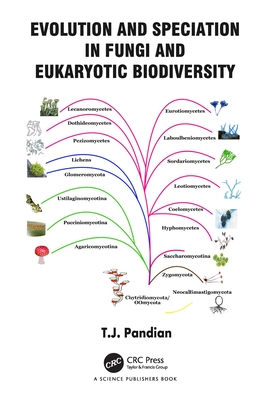Evolution and Speciation in Fungi and Eukaryotic Biodiversity

Evolution and Speciation in Fungi and Eukaryotic Biodiversity
Being sessiles like autotrophic plants and heterotrophics as animals, fungi are fascinating eukaryotes. In them, the need for external digestion has demanded surface expansion and limited tissues to 20% loss of commercial crops. Despite their ecological and economic importance, no university offers a degree course in Mycology. For 2,056,907 eukaryotic species, this book elaborates the role played by environmental factors (i) spatial distribution, (ii) light-temperature, (iii) precipitation-liquid water and biological attributes, (iv) cellularity, (v) symmetry, (vi) clonality, (vii) sexuality, (viii) modality and (ix) motility that either accelerate or decelerate biodiversity. About 20 and 80% eukaryotes are aquatics and terrestrials. Decreasing light intensity and temperature reduce diversity from the equator toward the polar zones. Water availability also reduces the diversity from 5.4 - 65.5 species/km2 in tropical evergreen forests to 200 in mammals reduces clonality from 100 to 0%. Strategies developed by eukaryotes reduce selfing by
PRP: 604.41 Lei
Acesta este Prețul Recomandat de Producător. Prețul de vânzare al produsului este afișat mai jos.
543.97Lei
543.97Lei
604.41 LeiIndisponibil
Descrierea produsului
Being sessiles like autotrophic plants and heterotrophics as animals, fungi are fascinating eukaryotes. In them, the need for external digestion has demanded surface expansion and limited tissues to 20% loss of commercial crops. Despite their ecological and economic importance, no university offers a degree course in Mycology. For 2,056,907 eukaryotic species, this book elaborates the role played by environmental factors (i) spatial distribution, (ii) light-temperature, (iii) precipitation-liquid water and biological attributes, (iv) cellularity, (v) symmetry, (vi) clonality, (vii) sexuality, (viii) modality and (ix) motility that either accelerate or decelerate biodiversity. About 20 and 80% eukaryotes are aquatics and terrestrials. Decreasing light intensity and temperature reduce diversity from the equator toward the polar zones. Water availability also reduces the diversity from 5.4 - 65.5 species/km2 in tropical evergreen forests to 200 in mammals reduces clonality from 100 to 0%. Strategies developed by eukaryotes reduce selfing by
Detaliile produsului










